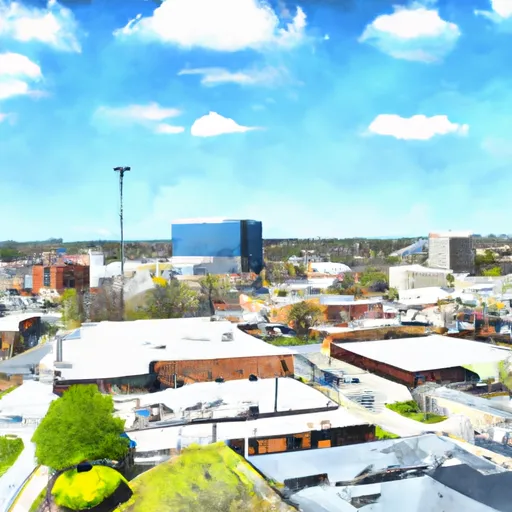-
 Snoflo Premium
Snoflo Premium
Get unlimited access to all our content
With no Ad interruptions! - Start Your Free Trial Login with existing account
Warner-Robins
Eden Index
Climate
8.3
•
Recreation
4.5
•
Community
2.6
•
Safeguard
5.5/10

Warner-Robins, Georgia, located in Houston County, offers a pleasant climate characterized by hot summers and mild winters. Summers are hot and humid, with average temperatures ranging from the high 80s to mid-90s Fahrenheit. Winters are generally mild, with average temperatures in the 40s and 50s Fahrenheit. The region experiences a significant amount of rainfall throughout the year, with an average annual precipitation of around 48 inches, spread fairly evenly across the months.
Hydrologically, Warner-Robins benefits from the presence of the Ocmulgee River, which provides a scenic waterway for various outdoor activities. Fishing enthusiasts can enjoy casting their lines for bass, catfish, and sunfish, among other species. Boating and kayaking are also popular activities, allowing visitors to explore the river's beauty and wildlife.
Apart from water-related activities, Warner-Robins offers a range of outdoor recreation opportunities. With several parks and green spaces, residents and visitors can engage in activities such as hiking, biking, picnicking, and playing sports. The Rigby's Water World is a popular attraction featuring water slides, wave pools, and other water-based entertainment options. The area's pleasant climate and abundant natural beauty make it an enticing destination for those who enjoy outdoor activities.
What is the Eden Index?
The Snoflo Eden Index serves as a comprehensive rating system for regions, evaluating their desirability through a holistic assessment of climate health, outdoor recreation opportunities, and natural disaster risk, acknowledging the profound impact of these factors on livability and well-being.
Climate Health Indicator (CHI): 8.3
Warner-Robins receives approximately
1148mm of rain per year,
with humidity levels near 84%
and air temperatures averaging around
18°C.
Warner-Robins has a plant hardyness factor of
8, meaning
plants and agriculture in this region tend to thrive here all year round.
By considering the ideal temperature range, reliable water supplies, clean air, and stable seasonal rain or snowpacks, the Climate Health Indicator (CHI) underscores the significance of a healthy climate as the foundation for quality living.
A healthy climate is paramount for ensuring a high quality of life and livability in a region, fostering both physical well-being and environmental harmony. This can be characterized by ideal temperatures, reliable access to water supplies, clean air, and consistent seasonal rain or snowpacks.
Weather Forecast
Streamflow Conditions
Altamaha
Area Rivers
Altamaha
Snowpack Depths
Altamaha
Reservoir Storage Capacity
Altamaha
Groundwater Levels
Recreational Opportunity Index (ROI): 4.5
The Recreational Opportunity Index (ROI) recognizes the value of outdoor recreational options, such as parks, hiking trails, camping sites, and fishing spots, while acknowledging that climate plays a pivotal role in ensuring the comfort and consistency of these experiences.
Access to outdoor recreational opportunities, encompassing activities such as parks, hiking, camping, and fishing, is crucial for overall well-being, and the climate plays a pivotal role in enabling and enhancing these experiences, ensuring that individuals can engage in nature-based activities comfortably and consistently.
Camping Areas
| Campground | Campsites | Reservations | Toilets | Showers | Elevation |
|---|---|---|---|---|---|
| Arrowhead County Park | None | 390 ft | |||
| Hard Labor Creek State Park | None | 713 ft | |||
| Warner Robins AFB Military | None | 348 ft | |||
| James Shackleford County Park | None | 904 ft | |||
| Reed Bingham State Park | None | 203 ft | |||
| Central City Park - State Fairgrounds | None | 295 ft | |||
| Newton Factory Shoals Rec Area | None | 608 ft | |||
| Dames Ferry County Park | None | 424 ft | |||
| Fort Yargo State Park | None | 914 ft | |||
| Claystone County Park | None | 410 ft |
Nearby Ski Areas
Catastrophe Safeguard Index (CSI):
The Catastrophe Safeguard Index (CSI) recognizes that natural disaster risk, encompassing floods, fires, hurricanes, and tornadoes, can drastically affect safety and the overall appeal of an area.
The level of natural disaster risk in a region significantly affects safety and the overall livability, with climate change amplifying these risks by potentially increasing the frequency and intensity of events like floods, fires, hurricanes, and tornadoes, thereby posing substantial challenges to community resilience and well-being.
Community Resilience Indicator (CRI): 2.6
The Community Resilience Indicator (CRI) recognizes that education, healthcare, and socioeconomics are crucial to the well-being of a region. The CRI acknowledges the profound impact of these elements on residents' overall quality of life. By evaluating educational resources, healthcare accessibility, and economic inclusivity, the index captures the essential aspects that contribute to a thriving community, fostering resident satisfaction, equity, and social cohesion.

